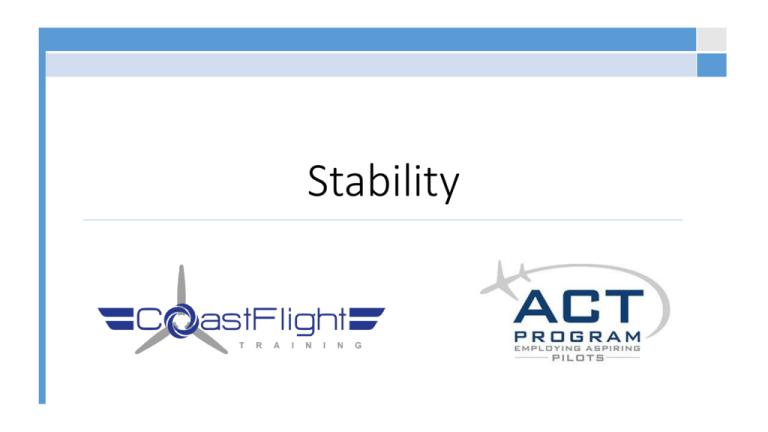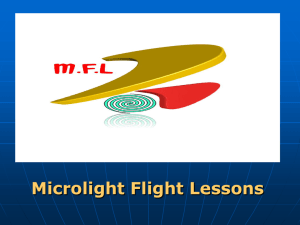
Stability
Stability
• Characteristic of an airplane that causes it to return to its equilibrium
• Comes in two types
• Static
• Dynamic
© 2015 Coast Flight Training. All Rights Reserved.
Controllability and Maneuverability
• Controllability is capability of airplane to respond to control inputs
• Maneuverability is characteristic of plane that permits you to
maneuver it easily and allows it to withstand stress
•
•
•
•
•
Size
Weight
Flight controls
Structural Strength
Thrust
© 2015 Coast Flight Training. All Rights Reserved.
Three Axes of Flight
• Longitudinal
• Lateral
• Vertical
• All referenced around the CG
© 2015 Coast Flight Training. All Rights Reserved.
Longitudinal Axis
• Movement with the ailerons
• Also known as roll
• Aileron works by decreasing angle of attack on one side, while
increasing the angle of attack on the other
© 2015 Coast Flight Training. All Rights Reserved.
Lateral Axis
• Movement with the elevator / stabilator
• Also known as pitch
• Elevator works by decreasing or increasing the angle of attack at the
horizontal stabilizer
© 2015 Coast Flight Training. All Rights Reserved.
Vertical Axis
• Movement with the rudder
• Also known as yaw
• Rudder works by decreasing or increasing the angle of attack at the
vertical stabilizer
© 2015 Coast Flight Training. All Rights Reserved.
Longitudinal Stability
• Refers to pitching of the aircraft – confusing
• Airplane returns to initial angle of attack
© 2015 Coast Flight Training. All Rights Reserved.
Longitudinal Stability - Balance
• Balance between:
• Center of Pressure
• Tail-down force
• Center of Gravity
• Boldmethod demonstration
• Airplanes have CG limits to keep longitudinally stable
© 2015 Coast Flight Training. All Rights Reserved.
Longitudinal Stability – CG location
• CG too far forward?
• Nose heavy
• Stable
• Eventually stabilator can’t lift nose
• CG too far aft? (more dangerous)
• Tail heavy
• Unstable
• Stabilator ineffective for stall or spin recover
© 2015 Coast Flight Training. All Rights Reserved.
Preventing Aft CG
• Load heaviest passengers in front
• Follow loading recommendations per the POH
• Never overload baggage
• Pause for the “speed limit talk”
© 2015 Coast Flight Training. All Rights Reserved.
Power and Pitch
• Related fundamentally
• Reduction in power results in a nose down tendency
• Increasing power increases downwash on the elevator, causing nose
to rise
© 2015 Coast Flight Training. All Rights Reserved.
Lateral Stability
• Refers to the roll - confusing
• Airplane return to level flight attitude (no bank)
© 2015 Coast Flight Training. All Rights Reserved.
Lateral Stability
• Design characteristics:
•
•
•
•
Weight distribution (minimally)
Dihedral
Sweepback
Keel Effect
© 2015 Coast Flight Training. All Rights Reserved.
Weight Distribution
• Imagine the airplane is a giant teeter-totter
• If too much weight on one side, then airplane wants to roll in
direction of the weight
• Pronounced with heavy flight-instructor and light student or vise
versa
© 2015 Coast Flight Training. All Rights Reserved.
Dihedral
• Dihedral is the airplane’s soft V shape
• If the aircraft turns, the lower wing creates more lift due to an
increased angle of attack
• Mainly only in sideslip conditions (crosswind)
• The more lift will roll the airplane back to level
© 2015 Coast Flight Training. All Rights Reserved.
Sweepback
• Wing tips are not directly across from the wing root
• Moves Center of Lift aft of the CG
• In a situation where the airplane is turning, the upwind wing creates
more drag, yawing it back to the right
© 2015 Coast Flight Training. All Rights Reserved.
Keel Effect
• Aircraft fuselage and wheels acts as a giant keel or centerboard like
on a ship
• Side area of the fuselage steadying the airplane
© 2015 Coast Flight Training. All Rights Reserved.
Directional Stability
• Stability controlled by the rudders (yaw)
• Mainly controlled by the vertical stabilizer
• Keel effect also controlled here
© 2015 Coast Flight Training. All Rights Reserved.
Static Stability
• Stability after an initial movement
• Does the airplane get away from initial movement? Stay at initial
movement? Or go back to it’s equilibrium?
• Think of a ball on a bowl or plate:
© 2015 Coast Flight Training. All Rights Reserved.
Dynamic Stability
• Stability over time
• Think of the oscillations of the aircraft
• Is the airplane going back to equilibrium or going away from?
• Helpful to draw graphs:
© 2015 Coast Flight Training. All Rights Reserved.
Stalls
• Stability changes the aircraft’s stall characteristics
• Important to do stalls in every new airplane to understand it’s
stability and stall characteristics
• Affected by:
•
•
•
•
•
Weight
Location of CG
Wing surface modifications
Ice or frost accumulation
Turbulence
© 2015 Coast Flight Training. All Rights Reserved.
Stalls - Weight
• Heavier aircraft means a higher angle of attack to maintain the same
amount of lift
• Heavy = increase stall speed
• Airplane AOA is much closer to the Critical AOA
© 2015 Coast Flight Training. All Rights Reserved.
Stalls - CG
• More forward CG creates more downward force to balance the
aircraft
• Wings must produce more lift
• Forward CG = Increase stall speed
© 2015 Coast Flight Training. All Rights Reserved.
The Lift Equation
1 2ρ
Lift = CL 2 v 2 S
© 2015 Coast Flight Training. All Rights Reserved.
Stalls – Surface of Wing
• The Lift Equation
• Any increase in wing surface area results in an increase of lift
• What changes the surface of the wing?
• High Lift Devices (Slats)
• Flaps
© 2015 Coast Flight Training. All Rights Reserved.
Stalls – Surface of Wing
• Ice or Frost accumulation interrupts smooth airflow
• Smooth airflow over the upper surface of wing is needed to create lift
• If the flow is disrupted, there is a huge reduction in lift
• Up to 60% reduction in lift
• Also increases weight and drag
• Always clear ice or frost from the surfaces on the airplane
© 2015 Coast Flight Training. All Rights Reserved.
Stalls – Turbulence
• Unpredictable nature of turbulence can cause the aircraft to stall at a
higher airspeed
• Vertical gusts change the direction of the relative wind and abruptly
increases the angle of attack
• During takeoff and landing in gusty conditions, increase speed to
compensate
© 2015 Coast Flight Training. All Rights Reserved.
Stalls – Turbulence
• If encountering turbulence, reduce the airplane to it’s maneuvering
speed
• Always calculate exact maneuvering speed before going flying
• The POH has only maximum and minimum
© 2015 Coast Flight Training. All Rights Reserved.
Why practice Stalls?
• We practice stalls to practice stall RECOVERY
• The set-up for the stall is not required for FAA certification, only the
recovery itself
• At Coast, we practice the set-up to aid in familiarization of WHEN the
stall will occur
• Also, we need to ensure that the individual is procedures oriented, which is
the goal of the Stage 1 check
© 2015 Coast Flight Training. All Rights Reserved.
Types of Stalls – What We Do at Coast
• Power-off
• Simulates a stall during the approach to landing
• Power-on
• Simulates a stall upon takeoff or departure
• Accelerated
• Simulates a stall at a higher airspeed
• We won’t practice these, but we will demonstrate them for you
© 2015 Coast Flight Training. All Rights Reserved.
Types of Stalls – Other
• Cross-controlled Stall
• Incoordination changes the relative wind, creating lift on one wing, but not on
the other
• Secondary Stalls
• Poor stall recovery technique
• Happens when positive control of the aircraft is not gained
• Aggravated Stall
• A stall that is held in a stall, recovery is not practiced or not completed
correctly
© 2015 Coast Flight Training. All Rights Reserved.
Stall Recognition
• Stall Warning Horn about 10 knots prior to the stall
• Mushy Controls (ineffective control movements)
• Loss of RPM may be evident
• Reduction in sound
• Buffeting
• Pitching
• Other Vibrations
• Sinking Feeling
© 2015 Coast Flight Training. All Rights Reserved.
Spins
• An aggravated stall that results in the airplane descending in a helical
or corkscrew path
• All light airplanes must demonstrate stall recovery – but performance
beyond these limits is unknown
• Never intentionally spin an aircraft without an instructor on board
• Only to be completed in utility category
© 2015 Coast Flight Training. All Rights Reserved.
Spins
• In order for a pin to happen, a stall must have occurred
• If uncoordinated, the wing that is more completely stalled will fall
before the other, causing a rotation in the direction of the stalled
wing
• The wing that is still creating lift, or partially stalled will continue the
rotation
© 2015 Coast Flight Training. All Rights Reserved.
Spins - Phases
• Incipient
• Rotation starts
• Fully Developed
• Rotation continues
• Recovery
• Wings regain lift
• Rotation stops
© 2015 Coast Flight Training. All Rights Reserved.
Spins -Types
• Erect Spin
• The “normal” spin
• Inverted Spin
• Aircraft is upside down
• Flat Spin
• Yaw only
• Killed goose
• Almost completely unrecoverable
© 2015 Coast Flight Training. All Rights Reserved.
Aerodynamics of
Maneuvering Flight
Climbing Flight
• Vector Diagram
© 2015 Coast Flight Training. All Rights Reserved.
Left Turning Tendencies
• P: Precession
• A: Asymmetrical Thrust
• S: Spiraling Slipstream
• T: Torque
© 2015 Coast Flight Training. All Rights Reserved.
Precession
• Same as a gyroscope
• An object spinning will have a force felt 90 degrees in the direction of
the rotation
• Right hand rule
© 2015 Coast Flight Training. All Rights Reserved.
Asymmetrical Thrust
• The downward motion of the propeller has a different resultant than
the upward side of the propeller blade
© 2015 Coast Flight Training. All Rights Reserved.
Spiraling Slipstream
• The fluid deflected by the propeller spirals around the fuselage and
hits the rudder.
© 2015 Coast Flight Training. All Rights Reserved.
Torque
• Newton’s 3rd: Every Action has an equal and opposite reaction
© 2015 Coast Flight Training. All Rights Reserved.
Lift to Drag Ratio
© 2015 Coast Flight Training. All Rights Reserved.
© 2015 Coast Flight Training. All Rights Reserved.
Load Factor
© 2015 Coast Flight Training. All Rights Reserved.
Maneuvering Speed
© 2015 Coast Flight Training. All Rights Reserved.







